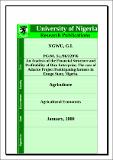UNNSpace Repository
An Analysis of the Financial Structure and Profitability of Rice Enterprise; The case of Adarice Project Participating farmers in Enugu State, Nigeria.
JavaScript is disabled for your browser. Some features of this site may not work without it.
| dc.contributor.author | Ngwu, Godwin Iloabuchi
|
|
| dc.date.accessioned | 2016-04-06T14:46:21Z | |
| dc.date.available | 2016-04-06T14:46:21Z | |
| dc.date.issued | 2016-04-06 | |
| dc.identifier.uri | http://hdl.handle.net/123456789/1469 | |
| dc.description.abstract | In order to help local farmers i~llprove on their rice production technique amongst other objectives, Adarice project adopted the participating farmers' scheme. Currently, the farmers engaged in rice production have reduced in number from one thousand in 1988 to three hundred and fourteen in 1998 rainy season with a lot of empty, uncultivated fields . wasting away. Consequently, the study analysed the financial structure and also ascertained the.profitability of the enterprise in order to determine whether they are the causes of the farmers' withdrawal from further producrion or not. Broadly, the study was an analysis of the financial structure and profitability of rice enterprise of Adarice project participating farmers in Enugu State, Nigeria. The spxil'ic objectives of the study were to describe the socio-economic characteristics of the participating farnlers; analyse the financial structure of the participating farmers' rice producrion enteprise; ascertain the profitability of the enterprise during the pre-harvest and post-harvest periods; describe the management problems from the view points of the prqiect's officials aid the participating farmers; and prof+r recommendations based on the study's f i d ings. The study area was Adarice pruiecr in UZO-~wanLio cal Government Arrd of Enugu State. The data required for the objectives (i) and (iv) were obtained by using two sets of stru.ctured questionnaire acln~inistered on both the project officials and the participating farmers. For objectives (ii) ;~ntl (iii). the data for the period of study and which are time-series were collected fro111 the financial records of the participating farmers. Data on objectives (i) and (iv) were annlysed using descriptive statistics. Data on objective (ii) were analysed using financial statements while data for objective (iii) were analysed using Net Profit Margin (NPM) tecl~~liqueA, nalysis of Variance and Student's tdistribution. The results showed that most ol the participating farmers were males (82%) and were married (67 %). The productioli enterprise was tedious and exhausted time, energy, - finance and other resources from the farmers. They showed also that most of the farmers had First School Leaving Certificate (FSLC) (47%) and West African School Certificate (WASC)/Teachers' Grade 11 certificate ('1'CII) (33%) and were able to keep good records. The Balance Sheet Results showed that 11)e farmers had no intermediate and fixed assets and medium - and long-term liabilities of their own. They relied on the project for the fixed and intermediate assets like land, maclii~icrya nd equipment , irrigation and storage facilities as well as on external labour. They oper,~~cocnIl y current assets and currelit liabilities. The current assets and current liabilities incrm+xI over the years in the period covered by the study for the cultivation of the same plot of land. The Net Profit Margin (NPM) technique results also showed a reducing trend olmined progressively over time within the period covered by the study. The results from the Analysis of Variance and t- distribution showed that there is a significant difference between the profitability of the enterprise during the pre-harvest and post-harvest periods. Data generated also indicated that the project's management had the problems of ineficilwr personnel ;in<! funds anlongst others as viewed vii by the project officials. As viewed by the participating farmers,, the nianagement problems encountered included high cost of production and capitallfinance amongst others. Bared on the findings it was recommended that amongst other things, soft loans should be provided by the government to the farmers to enable them overcome their capital firlance problems. The management of the project should be reorganised and the staff catered for. | en_US |
| dc.language.iso | en | en_US |
| dc.subject | Financial Structure Analysis | en_US |
| dc.subject | Rice Enterprise | en_US |
| dc.subject | Adarice Project | en_US |
| dc.subject | Rice farmers Profitability | en_US |
| dc.subject | Enugu State, Nigeria | en_US |
| dc.title | An Analysis of the Financial Structure and Profitability of Rice Enterprise; The case of Adarice Project Participating farmers in Enugu State, Nigeria. | en_US |
| dc.type | Thesis | en_US |
